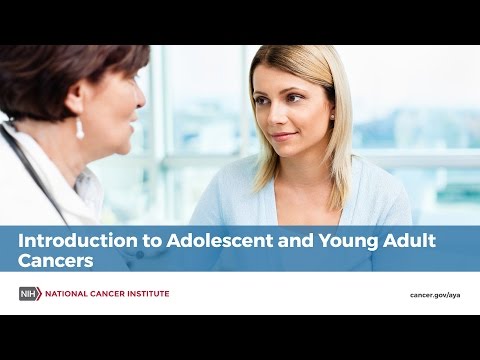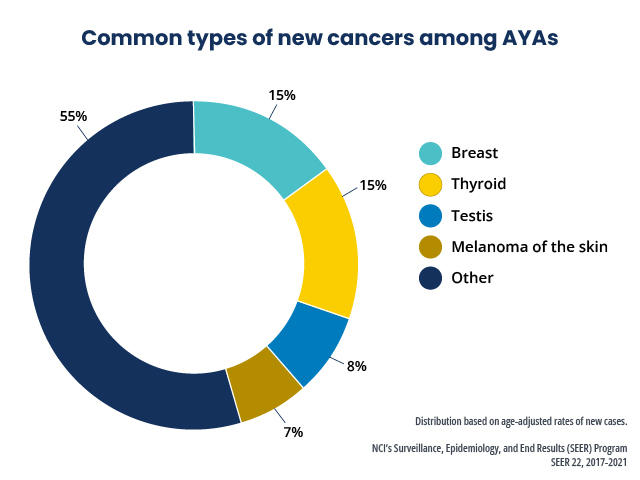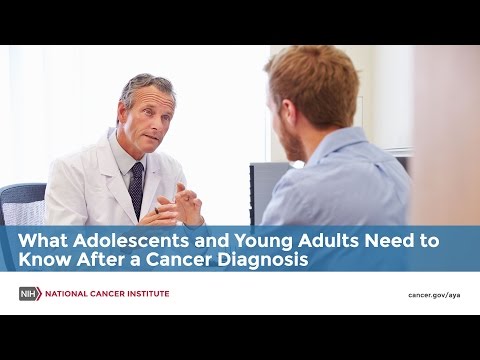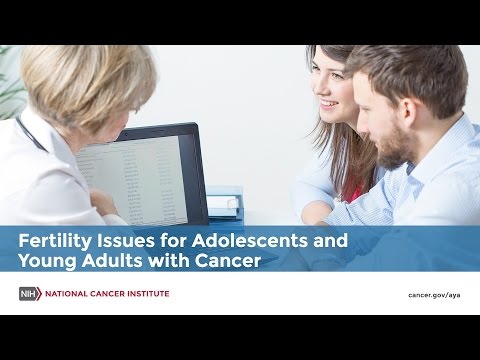Types of cancer in adolescents and young adults (AYAs)
An estimated 85,480 adolescents and young adults (AYAs) between the ages of 15 to 39 will be diagnosed with cancer in the United States in 2025. This accounts for about 4.2% of all cancer diagnoses.
Rates of new cancer cases of any site among AYAs have been rising on average 0.3% each year over 2013–2022, the last 10 years of available data. Death rates have been falling on average 0.9% each year over 2014–2023, according to Cancer Stat Facts: Cancer Among Adolescents and Young Adults (AYAs) (Ages 15–39), NCI’s Surveillance, Epidemiology, and End Results (SEER) Program which uses statistical models for analysis.
The most common cancers in adolescents and young adults (ages 15–39) are:
Other cancers in adolescents and young adults include brain and other central nervous system tumors, cervical cancer, colorectal cancer, leukemia, lymphoma, and sarcomas (including bone cancer and soft tissue sarcoma).
Learn how many different types of cancer are diagnosed and treated: A to Z cancer types.
Most common cancers by age group in adolescents and young adults
The incidence of specific cancer types varies according to age. Some cancers are more common in adolescents, while others are more common in young adults.
- In 15 to 19 year olds: thyroid cancer, Hodgkin lymphoma, brain and central nervous system tumors, and non-Hodgkin lymphoma are the most common cancer types.
- In 20 to 29 year olds: thyroid cancer, testicular cancer, melanoma, and Hodgkin lymphoma are the most common cancer types.
- In 30 to 39 year olds: breast cancer, thyroid cancer, melanoma, and colon and rectum cancer are the most common cancer types.
Statistical Summaries for Specific Types of Cancer
Learn about incidence, survival, mortality, and lifetime risk for many types of cancer.
Most common cancers in adolescents and young adults according to sex
Some types of cancers are more common in males, whereas other cancers are more common in females.
- In males, the most common AYA cancers include testicular cancer, colon and rectum cancer, non-Hodgkin lymphoma, and thyroid cancer.
- In females, the most common AYA cancers include breast cancer, thyroid cancer, melanoma, and cervical cancer.
Survival rates for cancers in adolescents and young adults
Survival rates are increasing among AYAs with cancer. While relative survival rates are high, at 86% for AYAs when all cancer types are combined, survival rates are much lower for some types of cancer than for others. Learn more about survival rates for different types of cancer.
Finding a doctor and hospital after a cancer diagnosis
Because cancer in young adults is rare, it is important to find an oncologist who specializes in treating the type of cancer you have. Depending on the type of cancer, young adults may have a better outcome when treated on a pediatric, rather than an adult treatment plan. For example, young adults with acute lymphoblastic leukemia (ALL) have better outcomes when treated with more intense “pediatric” type protocols.
Young adults who have a cancer that typically occurs in children and adolescents, such as brain tumors, leukemia, osteosarcoma, and Ewing sarcoma, may be treated by a pediatric oncologist. These doctors are often affiliated with a hospital that is a member of the Children’s Oncology Group. However, young adults who have cancers that are more common in adults, such as breast cancer or colorectal cancer, are often treated by a medical oncologist through hospitals that are affiliated with an NCI-Designated Cancer Center or a clinical research network such as the National Clinical Trials Network or NCI Community Oncology Research Program.
Getting a second opinion
When possible, it is important to get a second opinion on your cancer treatment plan. After you get a diagnosis and treatment plan from one oncologist, you may choose to get another doctor’s opinion. Most doctors will support and understand your interest in seeking a second opinion and your insurance company may even require a second opinion on the diagnosis and the treatment plan.
When possible, the second opinion should come from an oncologist who specializes in treating the type of cancer that you have. This doctor will usually be the most knowledgeable about the latest cancer treatments, including those for young adults. Seeing a specialist, and getting your initial treatment plan reviewed, can ensure that all aspects of care and treatment are considered. A second opinion may be especially helpful when the first opinion on the treatment plan comes from a doctor who doesn’t specialize in or treat many young adults with the type of cancer that you have. Learn more about finding a doctor and getting a second opinion in Finding Cancer Care.
Cancer treatment choices
The type of treatment you receive is based on factors such as:
- the type of cancer
- how advanced the cancer is, including its stage or grade
- biomarker and genetic test results for some types of cancer
- your age and overall health
- personal preferences
Treating cancer in adolescents and young adults
Common treatments include chemotherapy, immunotherapy, radiation therapy, stem cell transplants, surgery, and targeted therapy. Learn more about these treatments in Types of Cancer Treatment.
Your treatment options may include:
- Standard medical care (also called standard of care) is treatment that experts agree is appropriate and accepted for a specific disease, such as cancer. Check out the A to Z List of Cancers to learn about treatment for a specific type of cancer.
- Cancer treatment clinical trials, (also called clinical studies), are carefully controlled research studies that test new, potentially better, ways to treat cancer. Clinical trials are conducted in a series of steps, called phases. Each phase aims to answer specific medical questions. Learn more about adolescents and young adults with cancer enrolling in clinical trials sponsored by NCI’s Cancer Therapy Evaluation Program.
You can also read more about clinical trials, get answers to questions, and find a clinical trial.
Biomarker testing
Biomarker testing looks for biomarkers. Each person’s cancer has a unique pattern of biomarkers, but they have only been discovered for some cancers. Since some biomarkers affect how certain cancer treatments work, biomarker testing may be used to choose the best treatment for some types of cancer. Biomarker testing is different than genetic testing.
Genetic testing
Genetic testing for inherited cancers looks for specific inherited changes (variants) in a person’s genes. Harmful variants in some genes are known to be associated with an increased risk of developing cancer, in about 5% to 10% of all cancers.
Treatment decisions often come with questions and concerns, especially when considering participation in a clinical trial. We can help. Please contact our free, confidential Cancer Information Service at 1-800-4-CANCER (1-800-422-6237) for information and for help finding clinical trials.
Fertility preservation options
Cancer treatments can affect your fertility. It's important to talk with your doctor about whether or not the cancer treatment being advised may increase the risk of, or cause, infertility.
Meeting with a reproductive endocrinologist can help you learn about fertility preservation options before starting treatment. Learn more about fertility issues in girls and women and fertility issues in boys and men. Research has found that although discussions of fertility preservation between doctors and young adult cancer patients are becoming more common, improvements are still needed.
Organizations such as the Oncofertility Consortium and LIVESTRONG Fertility also provide fertility-related support and advice to young adults and health care professionals.
Coping and support for young people
Cancer can create a sense of isolation from friends and family, who may not understand what you are going through. As a young person, you may feel like you are losing your independence at a time when you were just starting to gain it. Perhaps you just began college, landed a job, or started a family. A desire for normalcy may keep you from sharing your experiences with friends.
Learn about unique ways that you can cope and find support: Emotional Support for Young People with Cancer.
Survivorship care planning
For many young people, the completion of treatment is something to celebrate. However, this time may also bring new challenges. You may worry that cancer will return or struggle to get used to new routines. Some young people enter this new phase feeling stronger, whereas others are more fragile. Most young people say the transition after treatment took longer and was more challenging than they anticipated. While most of the side effects that you had during treatment will go away, long-term side effects, such as fatigue, may take time to go away. Other side effects, called late effects, may not occur until months or even years after treatment.
Although follow-up care is important for all survivors, it is especially important for adolescents and young adults. These check-ups can both reassure you and help to prevent or treat medical and psychological problems. Some young people receive follow-up care at the hospital where they were treated, and others see specialists at late effect or survivorship care clinics. Talk with your health care team to learn what follow-up care you should receive and about possible places to receive this important care. Learn more in questions to ask your doctor when you have finished cancer treatment.
Important documents to get from your doctor and talk about include:
- Treatment summary, with detailed records about your diagnosis and the type(s) of treatment you received.
- Survivorship care plan or follow-up care plan, which addresses both physical and psychological follow-up care that you should receive after cancer treatment. The plan is based on the type of cancer and treatment you received and may vary from person to person.
You'll want to save both paper and electronic copies of these documents for your medical records. Learn more about Follow-Up Medical Care.
Cancer survivorship clinics and support groups
A growing number of hospitals have survivorship clinics, including programs that focus on follow-up care for young people who have been treated for cancer. Research is also ongoing through the Childhood Cancer Survivor Study to both increase survival rates and to better understand and minimize late effects.
Clinical trials are also working to improve survivorship care programs. One example is the Interactive Survivorship Program for the Improvement of Healthcare Resources in Adolescent and Young Adult Cancer Survivors, the INSPIRE-AYA Study. This study is working to improve access to survivorship resources and is developing an interactive survivorship program aimed at helping adolescents and young adults access follow-up care guidelines and reduce cancer-related distress.
Learn more about issues related to cancer survivorship, including late effects of treatment for adult cancers as well as late effects of treatment for childhood cancers.
End-of-life care decisions
If the cancer you have cannot be cured, or continues to progress despite treatment, it may be called end-stage cancer or terminal cancer. Being told that treatment isn’t working is exceptionally difficult to hear. Get suggestions that can help you have conversations and make choices about end-of-life care and support that are right for you: Young People Facing End-of-Life Care Decisions.
Organizations serving adolescents and young adults
A growing number of organizations serve the needs of AYAs with cancer. Some organizations help young people connect with peers who are going through the same things. Others address topics such as coping, fertility, and survivorship.
Young Adults
Teens and Adolescents
- CureSearch
- Elephants and Tea
- Starlight Children's Foundation
- Teen Cancer America
- 13thirty Cancer Connect
Coping and Practical Support
- CancerCare
- Cancer and Careers
- Imerman Angels
- MyLifeLine.org
- National Collegiate Cancer Foundation
- Triage Cancer
Fertility
Physical Activity and Outdoor Adventures
Survivorship
Cancer-related tools and statistics
Cancer-related statistics and statistical tools are available to help you understand cancer in AYAs from NCI’s Surveillance, Epidemiology and End Results (SEER) Program, including:
- statistics for cancer among adolescents and young adults (AYAs)
- statistics for many types of cancer
- tools including SEER Explorer and NCCR Explorer, which include data on age, race, and other subgroups, from Cancer Statistics Explorer Network





